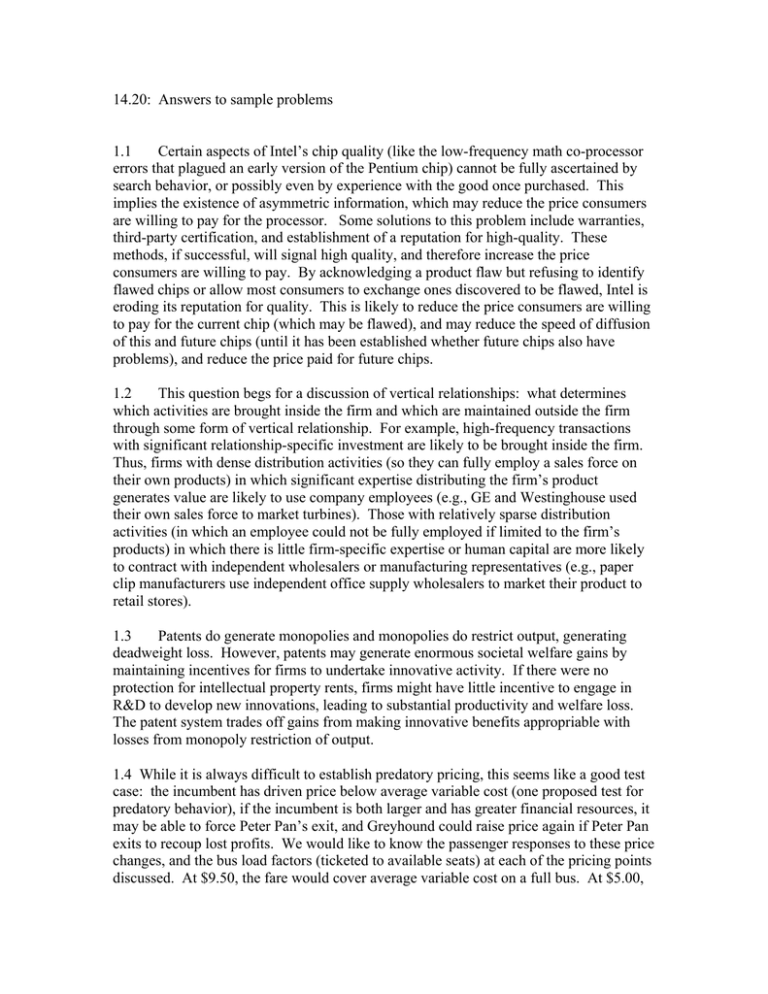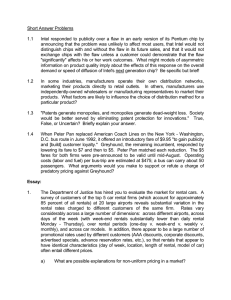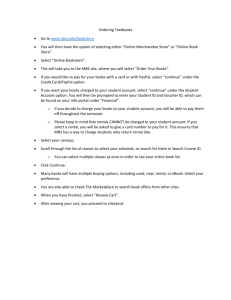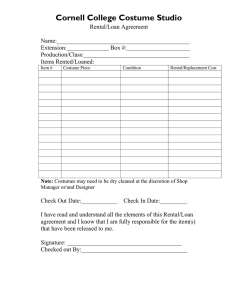14.20: Answers to sample problems 1.1
advertisement

14.20: Answers to sample problems 1.1 Certain aspects of Intel’s chip quality (like the low-frequency math co-processor errors that plagued an early version of the Pentium chip) cannot be fully ascertained by search behavior, or possibly even by experience with the good once purchased. This implies the existence of asymmetric information, which may reduce the price consumers are willing to pay for the processor. Some solutions to this problem include warranties, third-party certification, and establishment of a reputation for high-quality. These methods, if successful, will signal high quality, and therefore increase the price consumers are willing to pay. By acknowledging a product flaw but refusing to identify flawed chips or allow most consumers to exchange ones discovered to be flawed, Intel is eroding its reputation for quality. This is likely to reduce the price consumers are willing to pay for the current chip (which may be flawed), and may reduce the speed of diffusion of this and future chips (until it has been established whether future chips also have problems), and reduce the price paid for future chips. 1.2 This question begs for a discussion of vertical relationships: what determines which activities are brought inside the firm and which are maintained outside the firm through some form of vertical relationship. For example, high-frequency transactions with significant relationship-specific investment are likely to be brought inside the firm. Thus, firms with dense distribution activities (so they can fully employ a sales force on their own products) in which significant expertise distributing the firm’s product generates value are likely to use company employees (e.g., GE and Westinghouse used their own sales force to market turbines). Those with relatively sparse distribution activities (in which an employee could not be fully employed if limited to the firm’s products) in which there is little firm-specific expertise or human capital are more likely to contract with independent wholesalers or manufacturing representatives (e.g., paper clip manufacturers use independent office supply wholesalers to market their product to retail stores). 1.3 Patents do generate monopolies and monopolies do restrict output, generating deadweight loss. However, patents may generate enormous societal welfare gains by maintaining incentives for firms to undertake innovative activity. If there were no protection for intellectual property rents, firms might have little incentive to engage in R&D to develop new innovations, leading to substantial productivity and welfare loss. The patent system trades off gains from making innovative benefits appropriable with losses from monopoly restriction of output. 1.4 While it is always difficult to establish predatory pricing, this seems like a good test case: the incumbent has driven price below average variable cost (one proposed test for predatory behavior), if the incumbent is both larger and has greater financial resources, it may be able to force Peter Pan’s exit, and Greyhound could raise price again if Peter Pan exits to recoup lost profits. We would like to know the passenger responses to these price changes, and the bus load factors (ticketed to available seats) at each of the pricing points discussed. At $9.50, the fare would cover average variable cost on a full bus. At $5.00, even if every bus goes out full, Greyhound will not make enough to cover out-of-pocket expenses for the trip (revenue = 5*50= 250; operating costs = $475). This suggests higher overall profits is the trip is cancelled (absent spillovers to other bus trip demand). If we consider “spoilage” of seats (when the bus leaves with empty seats, the opportunity cost of another passenger is about 0), $5.00 is above very short-term marginal cost (i.e., MC at the level of this trip). But if we ask whether this can be profit-maximizing for Greyhound in the absence of strategic effects on Peter Pan, it seems unlikely. Essay: a. Prices may be non-uniform or nonlinear for a variety of reasons. These include peakload pricing (prices used to ration fluctuating demand given fixed capacity), cost variations in providing service, and price discrimination based on consumer search behavior and willingness to pay. b. Peak-load pricing: demand is likely to fluctuate, both predictably and unpredictably, in this market. If rental fleets are likely to be fully rented at particular times, the cost of these rentals should be higher. This would tend to predict, for example, a higher price for weekday rentals (when there is likely to be substantial business demand) and a lower price for weekend rentals (when demand is likely to be lower and capacity constraints less likely to be reached.) Cost variation: Costs are likely to vary across rentals, leading to further price variation. There are likely to be locational cost differences that may raise the marginal and average rental cost (e.g., locational rents, wage rates, etc.). Different car models have different capital costs, leading to different implied rental rates. Finally, there may be some fixed cost of transacting a rental, suggesting that the per-day cost of multi-day rentals is less than the per-day cost of a one-day rental. Price discrimination: Some of the price variation is almost certainly due to price discrimination. Rental car firms would appear to have some market power and an ability to prevent re-sale or arbitrage (rentals are legally non-transferable). Price discriminatino may exacerbate differentials based on one of the other reasons. For example, business travelers, who rent primarily on week-days, are likely to value rental cars more and have a lower demand elasticity. This will tend to imply a higher mark-up over the higher weekday cost, implying an even greater price differential weekday-weekend than implied by cost differentials. Promotional rates can be understood as price discrimination based on market segmentation and possibly on search costs (e.g., advertised specials). The nonlinear prices (where quantity is days of the rental period) may also involve price discrimination as well as simple cost differences. See the discussion of nonlinear prices/two-part tariffs in class.



